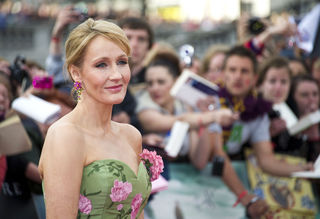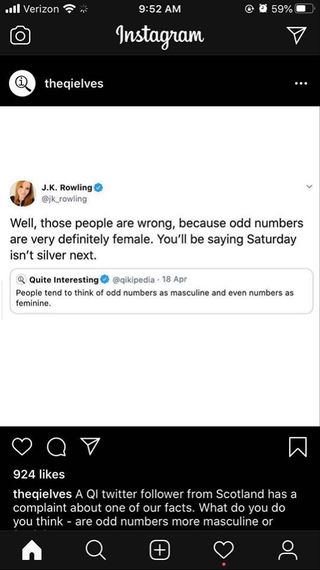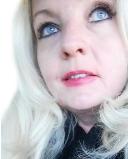Synesthesia
Could J.K. Rowling Be a Synesthete?
Harry Potter author posts colorful sensory impressions on social media.
Posted May 1, 2020 Reviewed by Devon Frye

She has rendered entire worlds which have taken their place in modern mythology with a depth and richness unparalleled even among fiction writers. J.K. Rowling—a British author, film producer, and philanthropist—has been seen by many as a top creative since her series of Harry Potter books and films.
And a recent tweet prompted speculation that she is also a synesthete. She expressed her sensory impressions on social media for the first time this month.
On April 18, when the site Quite Interesting posted that most people perceive odd numbers as male and even ones as female, Ms. Rowling wrote back this reply on Twitter:

"Well, those people are wrong, because odd numbers are very definitely female. You'll be saying Saturday isn't silver next."
The tweet was met with delight in the synesthesia community—and spotted first by talented artist Carrie C Firman. It may be yet another example of the potential advantage the brain trait gives to leading artists everywhere.
Patricia Lynne Duffy is the co-founder of the American Synesthesia Association and the author of the first book about synesthesia by a synesthete, Blue Cats and Chartreuse Kittens: How Synesthetes Color Their Worlds. The instructor in the United Nations Language and Communications Programme is also the foremost expert in the community about literature and synesthesia.
“It is no surprise to hear that J.K. Rowling [could be] a synesthete!" Ms. Duffy said upon hearing the news.
"All of the Harry Potter books are so full of brilliant cross-sensory metaphor and vivid imagery of all kinds. Things are always transforming into other things: magic wands emit power in the forms of green smoke, thundering sounds, and even snakes; the character ‘Moaning Myrtle’ has 'silver tears' and the character Ron’s 'studies are stinky'," she pointed out. "Neuroscientist V.S. Ramachandran tells us that synesthetes are good at metaphor. Because of their unique brain wiring, parts of the brain we wouldn't expect to communicate show cross-activation—leading synesthetes to come up with unexpected transformations and metaphorical descriptions.”
Ms. Duffy said that on a fanfiction site she found, the Rowling character "Hermione" is re-imagined as a synesthete who says that reading good books leaves her with a “warm brown feeling,” while books she doesn't like evoke “green or blue feelings.”
"Perhaps this is inspired by Rowling’s [potential] synesthetic perceptions?" Ms. Duffy speculated. "Rowling has said that, in many ways, the character was autobiographical, much like herself as a young girl."
Carrie C Firman, the artist who first noticed the posts, said it's satisfying to see Ms. Rowling express such unusual perceptions and it may have positive effects on other synesthetes, particularly younger ones finding their way.
"Our societies have such a high degree of pressure to perform and conform—it's a relief to hear so clearly that someone understands your experience," she said.
Just as profound, perhaps, are the experiences she had prior to and upon finding the post.
"I was browsing my Instagram feed, listening to my empty stomach growl in spirals and stretching serrated bands, when I saw J.K. Rowling's comment featured on the QI account feed." She says the color of the spirals and bands was a translucent white and the experience was "not uncommon when hearing noise."
Joel Salinas, M.D., is a polysynesthete and author of Mirror Touch: Notes From a Doctor Who Can Feel Your Pain about his own experiences with the profound empathy experienced by those with mirror-touch synesthesia. Dr. Salinas is also a neurologist, who bravely recently just started a position at New York University hospital during the COVID-19 pandemic.
"On the research side, there's been plenty published about a greater likelihood of synesthetes to generate ideas that are unique and new or novel to other people. People with synesthesia score higher on the openness on the big five personality tests," he explained upon hearing about the tweet by his fellow author. "Craftsmanship aside, having additional sensory information gives you more access to greater vocabulary when you're constructing the writing itself. And you're able to appreciate the full sensory experience of the reader. It creates a sense of variety and novelty."
To Dr. Salinas, synesthesia could be one possible framework to create the complex and entertaining realm Ms. Rowling has. He points out that, if she was confirmed to be a synesthete, her forms would appear to be ordinal linguistic (numbers to personalities or genders) and chromesthesia, or associating color with ideas.
"I think synesthesia may have played a role in the creation, expansion, and vividness of that world. Perhaps all it took was the serendipity of a small seed of an idea to land in her brain and crystallize the vision of that world," he said. "This may have happened along a rich scaffold of pre-existing, interconnected, synesthetic neural synapses, connecting all her memories and past experiences through serpentine pathways that in turn formed the scaffold for how she expanded on that world."
He added that the details of colors, shapes, sounds, smells, textures, tastes, personality traits, and infinitely more qualia throughout that world and its stories, "could then be told coherently and in microscopic specificity by interpreting what lay in front of her, speaking in the language of her [potential] synesthesia. In a way, it was speaking her truth by remaining Hufflepuff-loyal to the veracity of that vivid world."
Ms. Rowling's team said she couldn't comment further right now because she's "at the moment focusing on helping parents, teachers and children while everyone is confined to home by COVID-19, with Harry Potter At Home, at www.Wizardingworld.com a hub of information and activities to discover the magic of Harry Potter."




